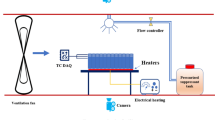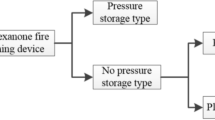Abstract
Lithium-ion battery applications are increasing for battery-powered vehicles because of their high energy density and expected long cycle life. With the development of battery-powered vehicles, fire and explosion hazards associated with lithium-ion batteries are a safety issue that needs to be addressed. Lithium-ion batteries can go through a thermal runaway under different abuse conditions including thermal abuse, mechanical abuse, and electrical abuse, leading to a fire or explosion. The NIOSH Mining program is conducting research to prevent and respond to lithium-ion battery fires for battery electric vehicles in the mining industry. In this study, experiments were conducted to investigate the effectiveness of different suppression systems including dry chemical, class D powder, and water mist for lithium iron phosphate battery pack fires. The effects of activation time and release time of the water mist system on the suppression of lithium-ion battery fires were studied. The results of this study may be helpful for developing strategic firefighting and response plans for battery-powered vehicles used in mining.









Similar content being viewed by others
Data Availability
Data is available upon request.
References
Kong L, Li C, Jiang J, Pecht MG (2018) Li-ion battery fire hazards and safety strategies. Energies 11:2191
Wang Q, Mao B, Stoliarov SI, Sun J (2019) A review of lithium-ion battery failure mechanisms and fire prevention strategies. Prog Energy Combust Sci 73:95–131
Sun P, Bisschop R, Niu H, Huang X (2020) A review of battery fires in electric vehicles. Fire Technol 56:1361–1410
Fernandes Y, Brya A, dePersisb S (2018) Identification and quantification of gases emitted during abuse tests by overcharge of a commercial Li-ion battery. J Power Sources 389:106–119
Golubkov AW, Fuchs D, Wagner J, Wiltsche H, Stangl C, Fauler G, Voitic G, Thaler A, Hacker V (2014) Thermal-runaway experiments on consumer Li-ion batteries with metal-oxide and olivine-type cathodes. RSC Adv 4:3633–3642
Larsson F, Andersson P, Blomqvist P, Mellander BE (2017) Toxic fluoride gas emissions from lithium-ion battery fires. Sci Rep 7:10018
Ogunfuye S, Sezer H, Said AO, Simeoni A, Akkerman V (2022) An analysis of gas-induced explosions in vented enclosure in lithium-ion batteries. Journal of Energy Storage 51:104438
Peng Y, Yang L, Ju X, Liao B, Ye K, Li L, Cai B, Ni Y (2020) A comprehensive investigation on the thermal and toxic hazards of large format lithium-ion batteries with LiFePO4 cathode. J Hazard Mater 381:120916
Ribiere P, Grugeon S, Morcrette M, Boyanov S, Laruelle S, Marlair G (2012) Investigation on the fire-induced hazards of lithium-ion battery cells by fire calorimetry. Energy Environ Sci 5:5271–5279
Meng L, Wang G, Wai K, Wang Y, Zhang Y, Zang C, Zhou R, Xie B (2022) Large-scale Li-ion battery research and application in mining industry. Energies 15:3884
Gillett S (2021) Battery electric vehicle emergency response incident review and best practices. Workplace Safety North Virtual Symposium: Battery Electric Vehicle Safety in Mines, January 20, 2021
NTSB (2020) Safety risks to emergency responders from lithium-ion battery fires in electric vehicles. Safety Report NTSB/SR-20/01.
Russo P, Di Bari C, Mazzaro M, De Rosa A, Morrielo I (2018) Effective fire extinguishing systems for lithium-ion battery. Chem Eng Trans 67:727–732
Said AO, Stoliarov SI (2021) Analysis of effectiveness of suppression of lithium ion battery fires with a clean agent. Fire Saf J 121:103296
Xu J, Guo P, Duan Q, Yu X, Zhang L, Liu Y, Wang Q (2020) Experimental study of the effectiveness of three kinds of extinguishing agents on suppressing lithium-ion battery fires. Appl Therm Eng 171:115076
Cui Y, Liu J, Han X, Sun S, Cong B (2022) Full-scale experimental study on suppressing lithium-ion battery pack fires from electric vehicles. Fire Saf J 129:103562
Quintiere JG (2022) On a method to mitigate thermal runaway and propagation in packages of lithium ion batteries. Fire Saf J 130:103573
Said AO, Garber A, Peng Y, Stoliarov SI (2022) Experimental investigation of suppression of 18650 lithium ion cell array fires with water mist. Fire Technol 58:523–551
Xu J, Duan Q, Zhang L, Liu Y, Zhao C, Wang Q (2021) Experimental study of the colling effect of water mist on 18650 lithium-ion battery at different initial temperatures. Process Saf Environ Prot 157:156–166
Zhang L, Duan Q, Liu Y, Xu J, Sun J, Xiao H, Wang Q (2021) Experimental investigation of water spray on suppressing lithium-ion battery fires. Fire Saf J 120:103117
GMG (2017) Recommended practices for battery electric vehicles in underground mining. Global Mining Guidelines (GMG), Ormstown, QC, CA,20160726 UG Mining BEV-GMSG-WG-v01-r01
Mao B, Liu C, Yang K, Li S, Liu P, Zhang M, Meng X, Gao F, Duan Q, Wang Q, Sun J (2021) Thermal runaway and fire behaviors of a 300 AH lithium ion battery with LiFePO4 as cathode. Renew Sustain Energy Rev 139:110717
Ping P, Wang Q, Huang P, Li K, Sun J, Kong D, Chen C (2015) Study of the fire behavior of high-energy lithium-ion batteries with full-scale burning test. J Power Sources 285:80–89
Wang Q, Huang P, Ping P, Du Y, Li K, Sun J (2017) Combustion behavior of lithium iron phosphate battery induced by external heat radiation. J Loss Prev Process Ind 49:961–969
Author information
Authors and Affiliations
Corresponding author
Ethics declarations
Conflict of Interest
The authors declare no competing interests.
Disclaimer
The findings and conclusions in this report are those of the authors and do not necessarily represent the official position of the National Institute for Occupational Safety and Health, Centers for Disease Control and Prevention. Mention of any company or product does not constitute endorsement by NIOSH.
Additional information
Publisher's Note
Springer Nature remains neutral with regard to jurisdictional claims in published maps and institutional affiliations.
Rights and permissions
About this article
Cite this article
Yuan, L., Tang, W., Thomas, R.A. et al. Experimental Study on Suppression of Lithium Iron Phosphate Battery Fires. Mining, Metallurgy & Exploration 41, 637–645 (2024). https://doi.org/10.1007/s42461-024-00938-y
Received:
Accepted:
Published:
Issue Date:
DOI: https://doi.org/10.1007/s42461-024-00938-y




